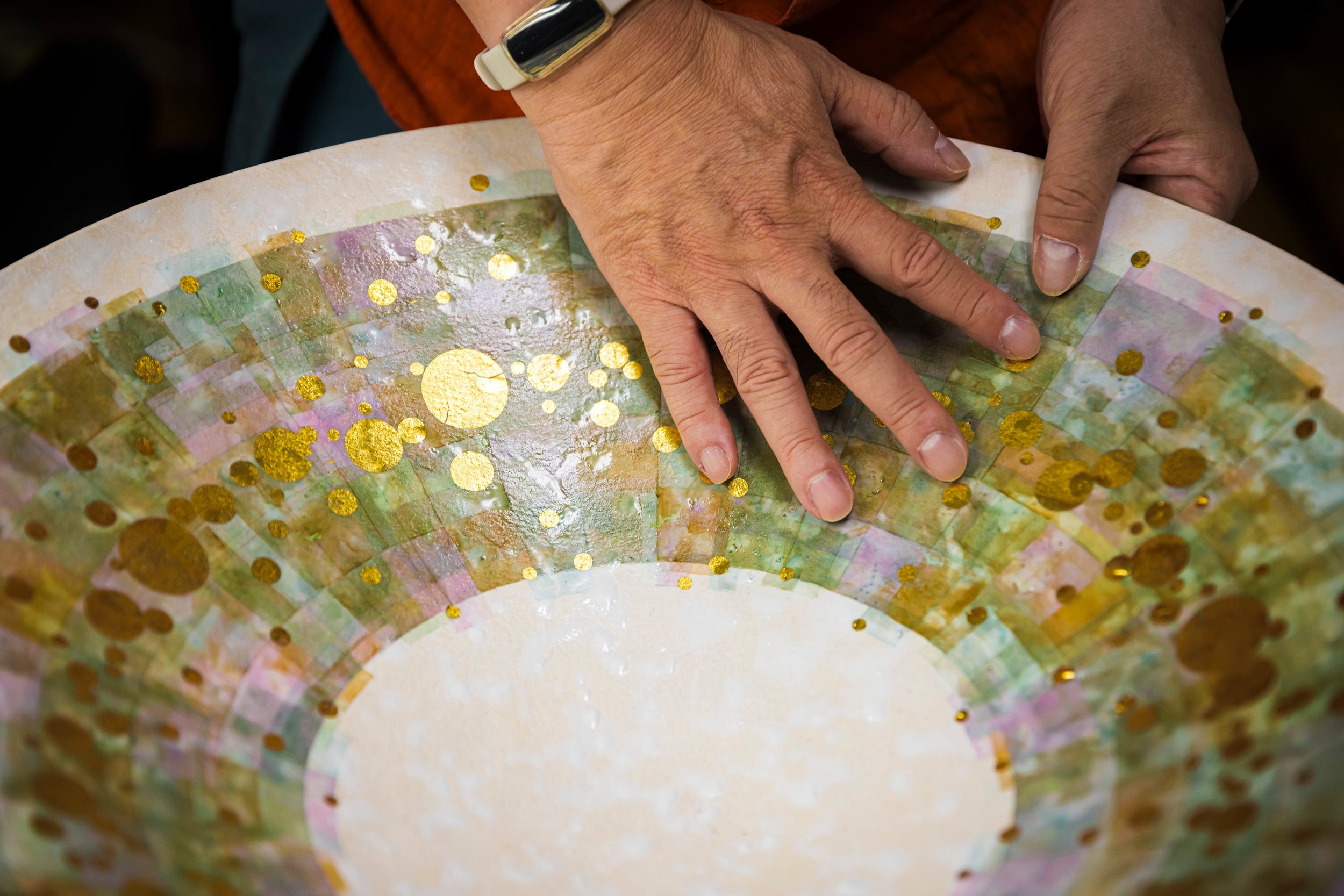![Tea: A Tool for Savoring Time [Part 1]](http://tabaya-unitedarrows.com/cdn/shop/articles/img-1739144687588_66836a19-b7c3-49fb-84ea-42ee3d4a44ee.jpg?v=1739180069&width=2500)
お茶は時を楽しむ道具【第一話】
常滑焼の最先端を見る
愛知県常滑市で150年以上の歴史を紡いできた窯元が生み出す「JINSUI」。庶民に広く愛された急須の歴史は、時代の変化を映す合わせ鏡のような物語でした。知っているようで知らなかった急須の秘密と、優しい色合いに込められた熱いクラフトマンシップに迫ります。

急須の郷、常滑市
常滑焼(とこなめやき)は愛知県常滑市で生産される日本の伝統的な陶器で、その歴史は平安時代から始まったとされています。瀬戸、越前、信楽、丹波、備前と並ぶ「日本六古窯」の一つとしても知られ、庶民が使う茶碗や皿が盛んに生産されていました。大きな甕や壺など、生活に必要な雑器も生産される一方で、江戸時代には素朴な風合いが文化人や茶人に好まれ、隆盛を極めます。明治時代には初代 山田常山(1868~1942)などの作家も誕生し、芸術的な茶器から庶民の愛用する急須まで常滑焼は広く知られることとなったのです。
とくに良質な粘土を使用した独特の赤茶色の急須は「朱泥急須(しゅでいきゅうす)」と呼ばれ、釉薬を使わない多孔質の素材がお茶の雑味を取り除くという特性があります。そのため常滑焼の急須でお茶を淹れると味がまろやかになると評判になり、常滑は急須のブランドとして地位を確立していきます。さらに、明治時代になると建築用のタイルや土管などの工業製品の産地としても発展し、日本の建築や土木に大きく貢献していくことになります。

工場の一角にはおよそ50種もの型が整然と並ぶ。

昔ながらの急須にノスタルジックな印象を受ける。

女性の職人も多く、働きやすい環境を整備している。
老舗であり、挑戦者でもある
モダンな急須ブランド「JINSUI」を展開する株式会社 人水(じんすい)は、常滑焼きの巧みな技術を現代に受け継ぐ窯元。窯の記録としては1850年頃の江戸時代までさかのぼることができたそうですが、地場産業を支えてきた一族の歴史はさらに古く、それはこの土地が連綿と日本のものづくりを支えてきた証といえそうです。その150年に及ぶ歴史は日本の急須や茶器の伝統だけでなく、品質やデザインへの挑戦でもあります。現在の代表を務める渡邉 裕介(わたなべ ゆうすけ)さんによれば、良い急須の条件とは「使い勝手が良く、お茶がうまくなる急須」に尽きるようですが、その基準は時代と共に変化します。
「例えば昔の急須は持ち手がいまよりも垂直に付いていました。畳の上でお茶を淹れていた時代は正座しているので、その方が持ちやすく注ぎやすかったのでしょう。同じように、茶葉を入れるときの蓋の持ちやすさ、注ぐときのバランスや蓋のフィット感などは誰もが分かる品質だったようですね。特に、お茶を淹れて手首を返すと、注ぎ口からパッとお茶が切れる“茶切れ”の良さはわたしたちがとても大切にしている機能のひとつです。急須でお茶を淹れるのが普通だった時代はそれだけ品質や違いの分かる人も多かった。そうやって厳しい目にさらされながら成長し、常に挑戦し続けることでお客様に選ばれてきたのだと思います。その姿勢は、ライフスタイルが多様化した現代でもかわることはありません」

石膏で型を取る「がば鋳込み」という伝統的な技術で作られる。

職人による繊細な手作業でひとつひとつ仕上げられていく。

日本の伝統を支える品質へのこだわりを感じる作業場。
伝統は細部に宿る
確かにいまではペットボトルでお茶を飲むのが当たり前になっていますが、それでも急須を作る技術も着実に進化していました。例えば急須の内部で茶葉を漉す部分。セラミックをメッシュ状にした「セラメッシュ」と呼ばれる技術ですが、メッシュ部を独自に配合した「ノタ」と呼ばれる泥で接着することで継ぎ目のない一体成形のような美しさを実現しています。胴の部分と同じ素材で作ることでお湯の温度が一定に保たれ、「ステンレスの茶漉しより絶対に美味しいと思う」と、その機能性に自信をのぞかせます。
他にも、蓋と胴の気密性を高める「蓋すり」は良い急須の必須条件です。急須の蓋と胴の間に磨き粉をつけて、ひとつずつ丁寧に摺り合わせることでお互いの表面が馴染み、ぴったりと密着されます。専用に開発された機械で研磨されていくと、ある瞬間に音が「すぅっ」と消えたように感じます。実に繊細な作業ですが、この密度によって茶葉が蒸れて味が良くなるだけでなく、注ぐときの安定感や使い心地も格段に向上します。胴と蓋はお互いがフィットするように調整されているので、別々に使うと微妙に合わなくなるほど精密に仕上げられています。

セラメッシュを丁寧に貼り付ける。ノタの成分は企業秘密。

蓋すりの作業と合わせて、茶切れの良さを確認する。

繊細な感覚で胴と蓋を馴染ませていくと、擦れる音が変わる。
味や使い勝手という品質
こうした技術は渡邉さんが独自に考えついたものなのでしょうか。
「難しい質問ですね。例えばシャツやズボンなどの技術に近いかもしれません。基本の型や技術のベースは伝統として受け継がれつつも、作り手によって少しずつ変化や進化するものだと思います。最初は機能として登場したものがデザインとして定着することもあるでしょうし、機械や素材が進化したことでアップデートされるものもある。例えばセラメッシュは、とある先輩の技術者に仕組みは教えてもらいましたが、機械そのものは自分で業者さんを探して作ってもらったものです。蓋すりにしても同じで、常滑の急須メーカーならみんなやっていると思いますが、それぞれ微妙に工夫が見てとれる部分です。急須というのはいわば庶民の道具なので、味や使い勝手という普遍的な機能はお客さんにちゃんと伝わるものです。だから美味しいお茶を飲みたいと思う人が増えれば、良い急須はちゃんと売れる。私はそういう急須ブランドを目指していきたいと思っています」

茶切れを左右する注ぎ口は熟練の手作業でカットされている。

使い込まれた道具たちが並ぶこの場所は、まさに職人の聖域。

削られた部分も捨てられることはなく、また素材に戻り循環していく。
茶の本質は時と間を愛でること
以前海外から来たゲストにコーヒーを出したら「急須でお茶を淹れてもらえるのを楽しみにしていた」と言われて慌てたことがあります。なぜなら我が家には急須がなかったのです。子供の頃はよく祖母が急須でお茶を淹れていましたが、いまではすっかり見ることがなくなってしまいました。あののんびりとした独特の時間こそが、暮らしに潤いを与えていたのかもしれません。そもそも「急須」も「急な用に応じて用いる」と書くように、手軽な使い勝手が起源とされています(※)。手軽さや便利さも贅沢のひとつなら、ゆっくりお茶を淹れるひとときも、また贅沢な選択肢のひとつ。急須が気になったら、人生を少しスローダウンさせるサインかもしれません。
※中国の手軽に酒を温める器「急須(キフス)」が語源という説や、薬として飲まれていた茶を煎じ、そのまま茶碗に注ぐ薬缶(やかん)の小さなものを「急焼(きびしょう)」としていたが、薬と分けるために「急須」と変えた説など、諸説あり。

急須を持つ手がピタリと馴染んでいるのが良く分かる。

伝統的な急須は柄が短く、手の大きい男性はこのような持ち方もしていた。

急須で飲むお茶には、焦りを鎮め、落ち着きを取り戻す作用がある。



![Tea: A Tool for Savoring Time [Part 2]](http://tabaya-unitedarrows.com/cdn/shop/articles/img-1739148391231_1c53f900-842d-4972-bd84-0698b9fbca89.jpg?v=1739180007&width=2500)